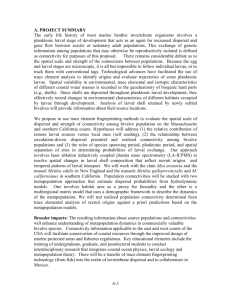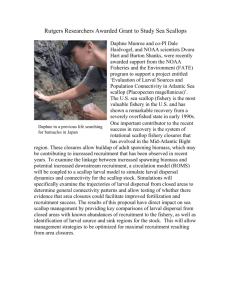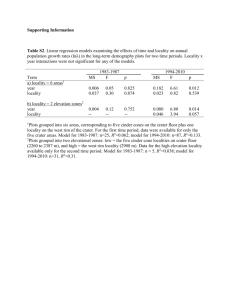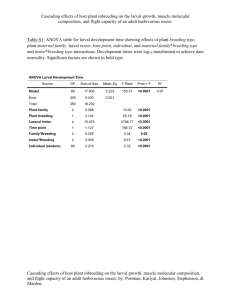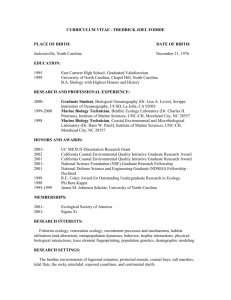A Guinea Pig`s History of Biology, by Jim Endersby
advertisement
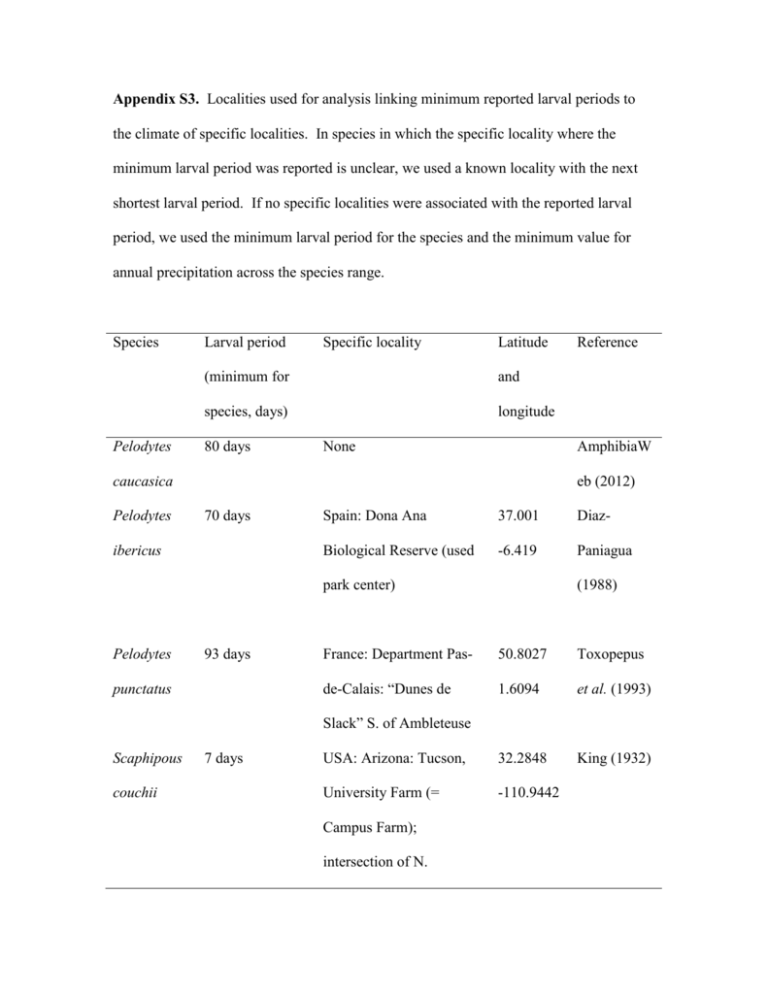
Appendix S3. Localities used for analysis linking minimum reported larval periods to the climate of specific localities. In species in which the specific locality where the minimum larval period was reported is unclear, we used a known locality with the next shortest larval period. If no specific localities were associated with the reported larval period, we used the minimum larval period for the species and the minimum value for annual precipitation across the species range. Species Pelodytes Larval period Specific locality Latitude (minimum for and species, days) longitude 80 days None AmphibiaW caucasica Pelodytes eb (2012) 70 days ibericus Spain: Dona Ana 37.001 Diaz- Biological Reserve (used -6.419 Paniagua park center) Pelodytes Reference 93 days punctatus (1988) France: Department Pas- 50.8027 Toxopepus de-Calais: “Dunes de 1.6094 et al. (1993) USA: Arizona: Tucson, 32.2848 King (1932) University Farm (= -110.9442 Slack” S. of Ambleteuse Scaphipous couchii 7 days Campus Farm); intersection of N. Campbell and E. Limberlost Scaphiopus 14 days holbrookii USA: Georgia: 31.0644 Wright Okefenokee Swamp -82.2713 (1932), (used northern edge for Wright & latitude and longitude) Wright (1949) Scaphiopus 13 days hurterii USA: Oklahoma: “central 35.232 Bragg Oklahoma” (Bragg, -97.208 (1965, 1967) USA: “western 34.5034 Bragg Oklahoma” (Bragg, 1967) -99.1409 (1962, 1967) 1967); used 16 miles E of Norman (from Bragg, 1965) Spea 14 days bombifrons use Tipton, Oklahoma (from Bragg, 1962) Spea 30 days (but with USA: California: “Our 33.91 Morey & hammondii no specific study area was located in -116.84 Reznick locality; Riverside County, Stebbins, 1951); California, USA, in the used 57 days western Mojave Desert.”; (Morey & used Banning, California (2001) Reznick, 2001) (easternmost site in Riverside County in our locality database) Spea 30 days (but with USA: California: Locality intermontan no specific a locality; Stebbins Counties” of California; given as “Mono and Inyo 1951); used 49 we have various localities days (7 weeks; in these counties, used one Morey & that is centrally located: Reznick 2000) 5 mi W and 4 mi N 37.88 Morey & -118.57 Reznick (2000) Benton, Mono County Spea 12 days USA: New Mexico: area 31.868 Pfennig et multiplicata (Pomeroy 1981; near Rodeo (used latitude -108.980 al. (1991) no specific and longitude of Rodeo) locality but SE Arizona); used 18 days (Pfennig et al., 1991) Pelobates 93 days (3 Spain: 7 km S. of 40.8953 Lizana et al. cultripes months) Salamanca -5.6605 (1993) Pelobates 93 days (3 Moscow 55.75 Kuzmin et fuscus months) 37.62 al. (1996) Pelobates 70 days None Kuzmin syriacus Pelobates (1999) 186 days None Schleich et varaldii Leptobrachi al. (1996) 62 days Singapore um nigrops Megophrys 77.5 days 1.35 Leong & 103.81 Chou (1999) None nasuta Wildenhues et al. (2012) References AmphibiaWeb: Information on amphibian biology and conservation. [web application]. 2012. Berkeley, California: AmphibiaWeb. Available: http://amphibiaweb.org/. Bragg, A.N. 1962. Further study of predation and cannibalism in spadefoot tadpoles. Herpetologica 20: 17–24. Bragg, A.N. 1965. Gnomes of the Night. University of Pennsylvania Press, Philadelphia, Pennsylvania, U.S.A. Bragg, A.N. 1967. Recent studies on the spadefoot toads. Bios. 38: 75–84. Diaz-Paniagua, C. 1988. Temporal segregation in larval amphibian communities in temporary ponds at a locality in SW Spain. Amphibia-Reptilia 9: 15–26. King, F.W. 1932. Herpetological records and notes from the vicinity of Tucson, Arizona, July and August, 1930. Copeia 1932: 175–177. Kuzmin, S.L. 1999. The Amphibians of the Former Soviet Union. Pensoft, Sofiya, Bulgaria. Kuzmin, S.L., Bobrov, V.V. & Dunaev, E.A. 1996. Amphibians of Moscow Province: distribution, ecology, and conservation. Zeitschrift für Feldherpetologie 3: 19–72. Leong, T.M., & Chou, L.M. 1999. Larval diversity and development in the Singapore anura (Amphibia). Raffles Bulletin of Zooogy 47: 82–137. Lizana, M., Rafael, M. & Matin-Sanchez, R. 1994. Reproductive biology of Pelobates cultripes (Anura: Pelobatidae) in Central Spain. J. Herpetol. 28: 19–27. Morey, S., & Reznick, D.N. 2000. A comparative analysis of plasticity in larval development in three species of spadefoot toads. Ecology 81: 1736–1749. Morey, S., & Reznick, D.N. 2001. Effects of larval density on postmetamorphic spadefoot toads (Spea hammondii). Ecology 82: 510–522. Nussbaum, R.A., Brodie, E.D. & Storm, R.M. 1983. Amphibians and Reptiles of the Pacific Northwest. University Press of Idaho, Moscow. Pfennig, D.W., Mabry, A. & Orange, D. 1991. Environmental causes of correlation between age and size at metamorphosis in Scaphiopus multiplicatus. Ecology 72: 2240–2248. Pomeroy, L.V. 1981. Developmental polymorphism in the tadpoles of the spadefoot toad Scaphiopus multiplicatus. Ph.D. Dissertation. University of California, Riverside, California, U.S.A. Schleich, H.H., Kästle, W., & Kabisch, K. 1996. Amphibians and Reptiles of North Africa. Koeltz Scientific Publishers, Koenigstein, Germany. Toxopeus, A.G., Ohm, & Arntzen, J.M. 1993. Reproductive biology of the parsley frog, Pelodytes punctatus, at the northernmost part of its range. Amphibia-Reptilia 14: 131–147. Wildenhues, M., Rauhaus, A., Bach, R., Karbe, D., Van der Straeten, K., Hartwig, S.T. & Ziegler, T. 2012. Husbandry, captive breeding, larval development and stages of the Malayan horned frog Megophrys nasuta (Schlegel, 1858) (Amphibia: Anura: Megophryidae). Amphibian and Reptile Conservation 5: 15–28. Wright, A.H. 1932. Life histories of the Frogs of the Okefenokee Swamp, Georgia. North American Salientia (Anura) Number 2. Macmillan Press, New York. Wright, A.H. & Wright, A.A. 1949. Handbook of Frogs and Toads of the United States and Canada. Cornell Univ. Press, Ithaca, New York.


